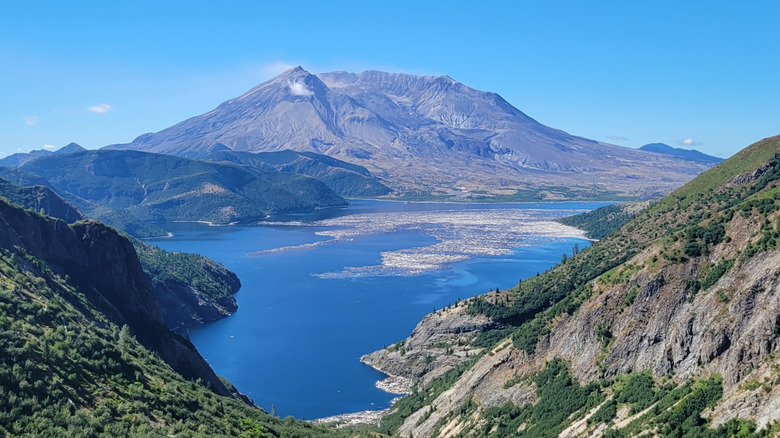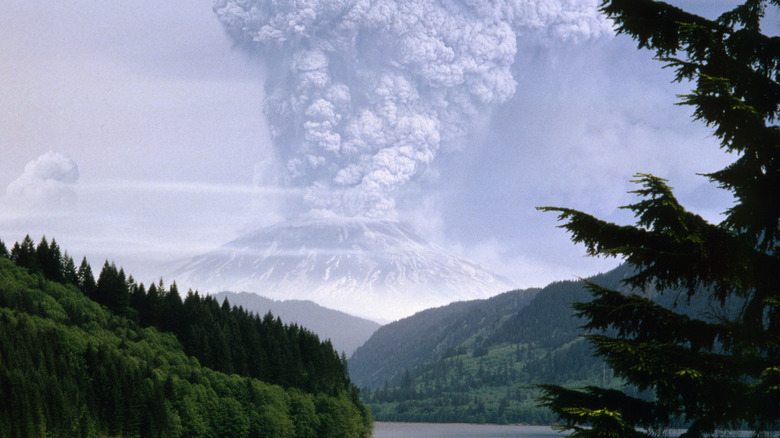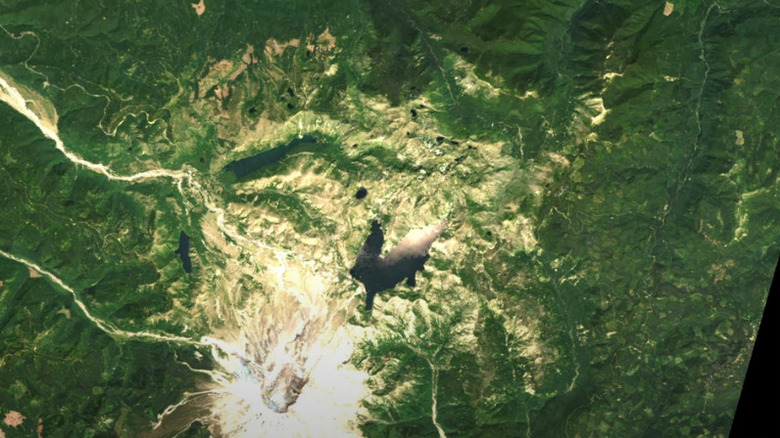This Picturesque Heart-Shaped Lake In The Pacific Northwest Survived America's Deadliest Eruption
The Northwest features many pretty mountains, lakes, and islands, each with its own fascinating history. However, few can hold a candle to Spirit Lake in Washington in terms of both beauty and history. Spirit Lake, which is about four hours south of Seattle, is located in quaint Skamania County and is a part of the stunning Cascade Range. But unlike the other lakes that populate this part of the country, when seen from above, Spirit Lake is in the shape of a heart (like the hearts you see during Valentine's Day, not the internal organ), although it didn't always look like that.
Before Spirit Lake got its distinctive shape, it was an alluring tourist attraction; the magnificent forests that surrounded the lake drew countless hikers and campers, and the lake itself was perfect for fishing and swimming. In fact, this little patch of heaven was home to numerous campsites, resorts, and lodges, all of which treated visitors to opulent natural views that only the Pacific Northwest could provide. However, Spirit Lake lost its status as a beloved vacation destination when it became the casualty of what would become America's deadliest volcanic eruption: the 1980 eruption of Mount St. Helens.
Tragically, the eruption of Mount St. Helens on May 18, 1980, ended Spirit Lake's decades as an alpine paradise. The event remains the most destructive eruption in American history, causing massive damage to the surrounding areas that totaled $1 billion (over $3,850,000 today), and killing 57 people in the process.
The volcanic eruption brought disaster to Spirit Lake
Because it's located just north of Mount St. Helens – which is a bucket list volcano hike that is just as dangerous as it is breathtaking — Spirit Lake wasn't spared from the natural disaster. The forest around the lake was devastated, and its waters were deeply contaminated by debris and toxic gases. The once thriving region became a lifeless, empty shell of what it used to be. In fact, Spirit Lake's geography experienced so much upheaval from the eruption that it took on the heart shape that it is known for today.
Still, it would only be a few years after that fateful day that Spirit Lake's ecology started showing signs of revival and evolving into a new form. The process may be slow, but here's hoping that Spirit Lake will someday return to its state as a tourist hotspot. And, despite its destructive past, Mount St. Helens remains one of many top volcanoes to visit in America for an unforgettable experience.
Spirit Lake's life today
The forests around Spirit Lake are nowhere near as lush and verdant as they were before the 1980 eruption, though vegetation is beginning to grow in areas once covered in thick layers of ash, signaling new signs of life in the region. Gone are the peaceful resort days of Spirit Lake, but parts of the region are still open to the public. There are still plenty of hiking trails around the lake that offer numerous opportunities to see its unique shape; Windy Ridge Viewpoint and Harmony Viewpoint deliver some particularly stunning views.
If you plan to visit Spirit Lake, it's recommended that you take Forest Road 99 to the Harmony Falls Trail, which is the only entrance accessible to visitors; the surrounding areas are reserved for scientific research. Because nearby roads are usually closed during the colder months, the ideal time to explore the area is between late spring and early fall.
Once you're at Spirit Lake, you'll notice one of its more fascinating features, which is the large number of logs that float on its surface due to the massive mudslides caused by Mount St. Helens' eruption. Seasonal changes and shifting winds cause the logs to migrate around the lake to varying degrees, posing a unique danger to those who get in the water, thereby making it one of the numerous U.S. lakes you'd want to think twice before swimming in. Swimming and boating are no longer allowed at Spirit Lake to help prevent accidents.


